Effect of Surface Modifications of Recycled Concrete Aggregate on Concrete Properties
Abstract
:1. Introduction
2. Material and Methods
- (a)
- coating of RCA during the mixing of concrete, and
- (b)
- coating of RCA prior to the mixing of concrete.
- -
- coal fly ash (FA) from the heating plant in Kosice, Slovakia,
- -
- liquid glass (Na2SiO3),
- -
- 8M NaOH solution, and
- -
- water.
- -
- amount of cement per cubic meter (370 kg), and
- -
- aggregate fraction ratio (0/4:4/8 = 60:40).
- The coating of RCA during the mixing of concrete (sample B2). Here, the mixing procedure was divided into the following steps: the fraction 4/8 of RCA was coated by geopolymer slurry in the standard laboratory mixer. The coated RCA was left to rest for 30 min in the mixer and then the mixing continued by adding the cement to form a further layer on the wet aggregate. Finally, fine aggregate, water, and plasticizer were added.
- The coating of RCA prior to the mixing of concrete (sample B3): the RCA was coated in standard laboratory mixer and was subsequently cured for 28 days under standard laboratory conditions, as given for making the concrete specimens (95% RH and 20 ± 3 °C). Then, the concrete was mixed by standard course [36], using coated and hardened RCA and adding the cement, fine aggregate, water, and plasticizer.
- -
- F is the surface area of aggregates (m2), and
- -
- δ is the thickness of layer (μm).
- -
- f is the coefficient characterising the surface quality of aggregate (12 is given for the poor surface quality),
- -
- ρb is the loose bulk density of aggregate (kg/m3),
- -
- ρp is the particle density (kg/m3),
- -
- pi is the amount of aggregate having average grain size di (%), and
- -
- di is the average grain size of aggregates fraction (mm).
3. Results and Discussion
4. Conclusions
- -
- Using the geopolymer slurry to coat the RCA results in higher density of concrete when compared with the same concrete prepared by standard mixing—6% increase in the case of B2 and 1.4% in the case of B3, when evaluating 28-day values.
- -
- Both methods of coating the RCA with geopolymer slurry result in a positive effect on the water absorption of concrete, although it significantly occurs after a longer time. Decrease of water absorption is 3.3% for B2 and 9% for B3 sample when evaluating 28-day values, while it is 46% for B2 and 51% for B3 when evaluating 365-day values.
- -
- Both of the methods of coating the RCA with geopolymer slurry result in a positive effect on the compressive strength of concrete; the early values are only a little lower than that of standard concrete with natural aggregate (13.0% for B2; 15.0% for B3), while the long-term values are fully comparable (even increase for B2 + 3.0%, 0.5% decrease for B3).
- -
- Both methods of coating the RCA with geopolymer slurry allow for the preparation of concrete with properties that are comparable to those of concrete with natural aggregate prepared by standard mixing; thus, it seems to be a promising way to enhance the rate of RCA application,
- -
- When comparing the methods of RCA coating, directly applying the coating during the mixing yields somewhat better results, especially from long-term point of view. The density is higher by 4.0% and compressive strength by 3.4%.
Acknowledgments
Author Contributions
Conflicts of Interest
References
- Jouhara, H.; Czajczynska, D.; Ghazal, H.; Kryzynska, R.; Anguilano, L.; Reynolds, A.J.; Spencer, N. Municipal waste management system for domestic use. Energy 2017, 139, 485–506. [Google Scholar] [CrossRef]
- Junak, J. Green concrete: Environmentally friendly concrete made from alternative materials. In Proceedings of the International Multidisciplinary Scientific GeoConference SGEM, Albena, Bulgaria, 18–24 June 2015; STEF92: Sofia, Bulgaria, 2015; pp. 147–154. [Google Scholar]
- Vaclavik, V.; Ondrasikova, I.; Dvorsky, T.; Cernochova, K. Leachate from municipal waste landfill and its natural degradation—A case study of Zubri, Zlin region. Int. J. Environ. Res. Public Health 2016, 13, 873. [Google Scholar] [CrossRef] [PubMed]
- Junakova, N.; Junak, J.; Balintova, M. Reservoir sediment as a secondary raw material in concrete production. Clean Technol. Environ. Policy 2015, 17, 1161–1169. [Google Scholar] [CrossRef]
- Waste Statistic. Available online: http://ec.europa.eu/eurostat/statistics-explained/index.php/Waste_statistics (accessed on 23 November 2017).
- Junak, J.; Sicakova, A. Concrete containing recycled concrete aggregate with modified surface. Procedia Eng. 2017, 180, 1284–1291. [Google Scholar] [CrossRef]
- Pellegrino, C.; Faleschini, F. Chapter 2: Recycled aggregates for concrete production: State-of-the-art. In Sustainability Improvements in the Concrete Industry, 1st ed.; Springer International Publishing: Cham, Switzerland, 2016; pp. 5–34. ISBN 978-3-319-28538-2. [Google Scholar]
- Kuosa, H. Reuse of Recycled Aggregates and Other C & D Wastes; Research Report VTT-R-05984-12; VTT Technical Research Centre of Finland Ltd.: Espoo, Finland, 2012. [Google Scholar]
- Kubissa, W.; Jaskulski, R.; Koper, A.; Szepetulski, J. Properties of concretes with natural aggregate improved by RCA addition. Procedia Eng. 2015, 108, 30–38. [Google Scholar] [CrossRef]
- Koper, A.; Koper, W.; Koper, M. Influence of raw concrete material quality on selected properties of recycled concrete aggregates. Procedia Eng. 2017, 172, 536–543. [Google Scholar] [CrossRef]
- Serifou, M.; Sbartai, Z.M.; Yotte, S.; Boffoue, M.O.; Emeruwa, E. A study of concrete made with fine and coarse aggregates recycled from fresh concrete waste. J. Constr. Eng. 2013, 2013, 317182. [Google Scholar] [CrossRef]
- Malesev, M.; Radonjanin, V.; Marinkovic, S. Recycled concrete as aggregate for structural concrete production. Sustainability 2010, 2, 1204–1225. [Google Scholar] [CrossRef]
- Ismail, S.; Kwan, W.H.; Ramli, M. Mechanical strength and durability properties of concrete containing treated recycled concrete aggregates under different curing conditions. Constr. Build. Mater. 2017, 155, 296–306. [Google Scholar] [CrossRef]
- Rahal, K. Mechanical properties of concrete with recycled coarse aggregate. Build. Environ. 2007, 42, 407–415. [Google Scholar] [CrossRef]
- Fan, C.-C.; Huang, R.; Chao, S.-J. The effects of different fine recycled concrete aggregates on the properties of mortar. Materials 2015, 8, 2658–2672. [Google Scholar] [CrossRef]
- Zhang, H.; Zhao, Y. Integrated interface parameters of recycled aggregate concrete. Constr. Build. Mater. 2015, 101, 861–877. [Google Scholar] [CrossRef]
- Paul, S.C.; Panda, B.; Garg, A. A novel approach in modelling of concrete made with recycled aggregates. Measurement 2018, 115, 64–72. [Google Scholar] [CrossRef]
- Sidorova, A.; Vazquez-Ramonich, E.; Barra-Bizinotto, M.; Roa-Rovira, J.J. Study of the recycled aggregates natures influence on the aggregate-cement paste interface and ITZ. Constr. Build. Mater. 2014, 68, 677–684. [Google Scholar] [CrossRef]
- Ryu, J.S. Improvement on strength and impermeability of recycled concrete made from crushed concrete coarse aggregate. J. Mater. Sci. Lett. 2002, 21, 1565–1567. [Google Scholar] [CrossRef]
- Li, T.; Xiao, J.; Zhu, C. Hydration process modeling of ITZ between new and old cement paste. Constr. Build. Mater. 2016, 109, 120–127. [Google Scholar] [CrossRef]
- Xiao, J.; Li, W.; Sun, Z.; Lange, D.A.; Shah, S.P. Properties of interfacial transition zones in recycled aggregate concrete tested by nanoindentation. Cem. Concr. Compos. 2013, 37, 276–292. [Google Scholar] [CrossRef]
- Ann, K.Y.; Moon, H.Y.; Kim, Y.B.; Ryou, J. Durability of recycled aggregate concrete using pozzolanic materials. Waste Manag. 2008, 28, 993–999. [Google Scholar] [CrossRef] [PubMed]
- Corinaldesi, V.; Moriconi, G. Influence of mineral additions on the performance of 100% recycled aggregate concrete. Constr. Build. Mater. 2009, 23, 2869–2876. [Google Scholar] [CrossRef]
- Sunayana, S.; Barai, S.V. Recycled aggregate concrete incorporating fly ash: Comparative study on particle packing and conventional method. Constr. Build. Mater. 2017, 156, 376–386. [Google Scholar] [CrossRef]
- Ryou, J.S.; Lee, Y.S. Characterization of Recycled coarse aggregate (RCA) via a surface coating method. Int. J. Concr. Struct. Mater. 2014, 8, 165–172. [Google Scholar] [CrossRef]
- Kim, N.-W.; Lee, S.-N.; Kang, S.-H.; Bae, J.-S. A study on the mechanical properties of concrete using the recycled aggregates by surface coating. J. Korean Soc. Civ. Eng. 2005, 25, 387–393. [Google Scholar]
- Choi, H.; Choi, H.; Lim, M.; Inoue, M.; Kitagaki, R.; Noguchi, T. Evaluation on the mechanical performance of low-quality recycled aggregate through interface enhancement between cement matrix and coarse aggregate by surface modification technology. Int. J. Concr. Struct. Mater. 2016, 10, 87–97. [Google Scholar] [CrossRef]
- Li, J.; Xiao, H.; Zhou, Y. Influence of coating recycled aggregate surface with pozzolanic powder on properties of recycled aggregate concrete. Constr. Build. Mater. 2009, 23, 1287–1291. [Google Scholar] [CrossRef]
- Kong, D.; Lei, T.; Zheng, J.; Ma, C.; Jiang, J.; Jiang, J. Effect and mechanism of surface-coating pozzalanics materials around aggregate on properties and ITZ microstructure of recycled aggregate concrete. Constr. Build. Mater. 2010, 24, 701–708. [Google Scholar] [CrossRef]
- Urban, K.; Sicakova, A. Impact of specific mixing method on the properties of concrete with BFS aggregate. In Proceedings of the 16th International Multidisciplinary Scientific GeoConference SGEM, Albena, Bulgaria, 28 June–6 July 2016; STEF92: Sofia, Bulgaria, 2016; pp. 49–56. [Google Scholar]
- Ferraris, C.F. Concrete mixing methods and concrete mixers: State of Art. J. Res. Natl. Bur. Stand. 2001, 106, 391–399. [Google Scholar] [CrossRef] [PubMed]
- Rejeb, S.K. Improving compressive strength of concrete by a two-step mixing method. Cem. Concr. Res. 1996, 26, 585–592. [Google Scholar] [CrossRef]
- Davidovits, J. Geopolymer Cement: A Review; Institut Geopolymere: Saint-Quentin, France, 2013. [Google Scholar]
- Jo, D.-W.; Park, S.-K.; Park, J.-B. Properties of concrete made with alki-activated fly ash lightweight aggregate (ALFA). Cem. Concr. Compos. 2007, 29, 128–135. [Google Scholar] [CrossRef]
- Gesoglu, M.; Ozturan, T.; Guneyisi, E. Effects of fly ash properties on characteristics of cold-bonded fly ash lightweight aggregate. Constr. Build. Mater. 2007, 21, 1869–1878. [Google Scholar] [CrossRef]
- Slovak Office of Standards, Metrology and Testing. STN EN 12390-2: Testing Hardened Concrete—Part 2: Making and Curing Specimens for Strength Tests; Slovak Office of Standards, Metrology and Testing: Bratislava, Slovakia, 2000.
- Lee, C.-H.; Du, J.-C.; Shen, D.-H. Evaluation of pre-coated recycled concrete aggregate for hot mix asphalt. Constr. Build. Mater. 2012, 28, 66–71. [Google Scholar] [CrossRef]
- Slovak Office of Standards, Metrology and Testing. STN EN 12390-7: Testing Hardened Concrete—Part 7: Density of Hardened Concrete; Slovak Office of Standards, Metrology and Testing: Bratislava, Slovakia, 2009.
- Slovak Office of Standards, Metrology and Testing. STN EN 12390-3: Testing Hardened Concrete—Part 3: Compressive Strength of Test Specimens; Slovak Office of Standards, Metrology and Testing: Bratislava, Slovakia, 2009.
- Gupta, A.; Ghosh, S.; Mandal, S. Coated recycled aggregate concrete exposed to elevated temperature. Glob. J. Res. Eng. 2012, 12, 1–7. [Google Scholar]
- Urban, K.; Sicakova, A. The influence of kind of coating additive on the compressive strength of RCA-based concrete prepared by triple-mixing method. In Proceedings of the 1st International Conference on Advances in Environmental Engineering (AEE 2017), Ostrava, Czech Republic, 28–30 November 2017; Volume 92, pp. 1–5. [Google Scholar]
- Wallah, S.E.; Rangan, B.V. Low-Calcium Fly Ash-Based Geopolymer Concrete: Long-Term Properties; Research Report GC2; Faculty of Engineering, Curtin University of Technology: Perth, Australia, 2006. [Google Scholar]
- Evans, J.D. Straightforward Statistic for the Behavioral Science, 1st ed.; Brooks-Cole Publishing: Pacific Grove, CA, USA, 1996. [Google Scholar]
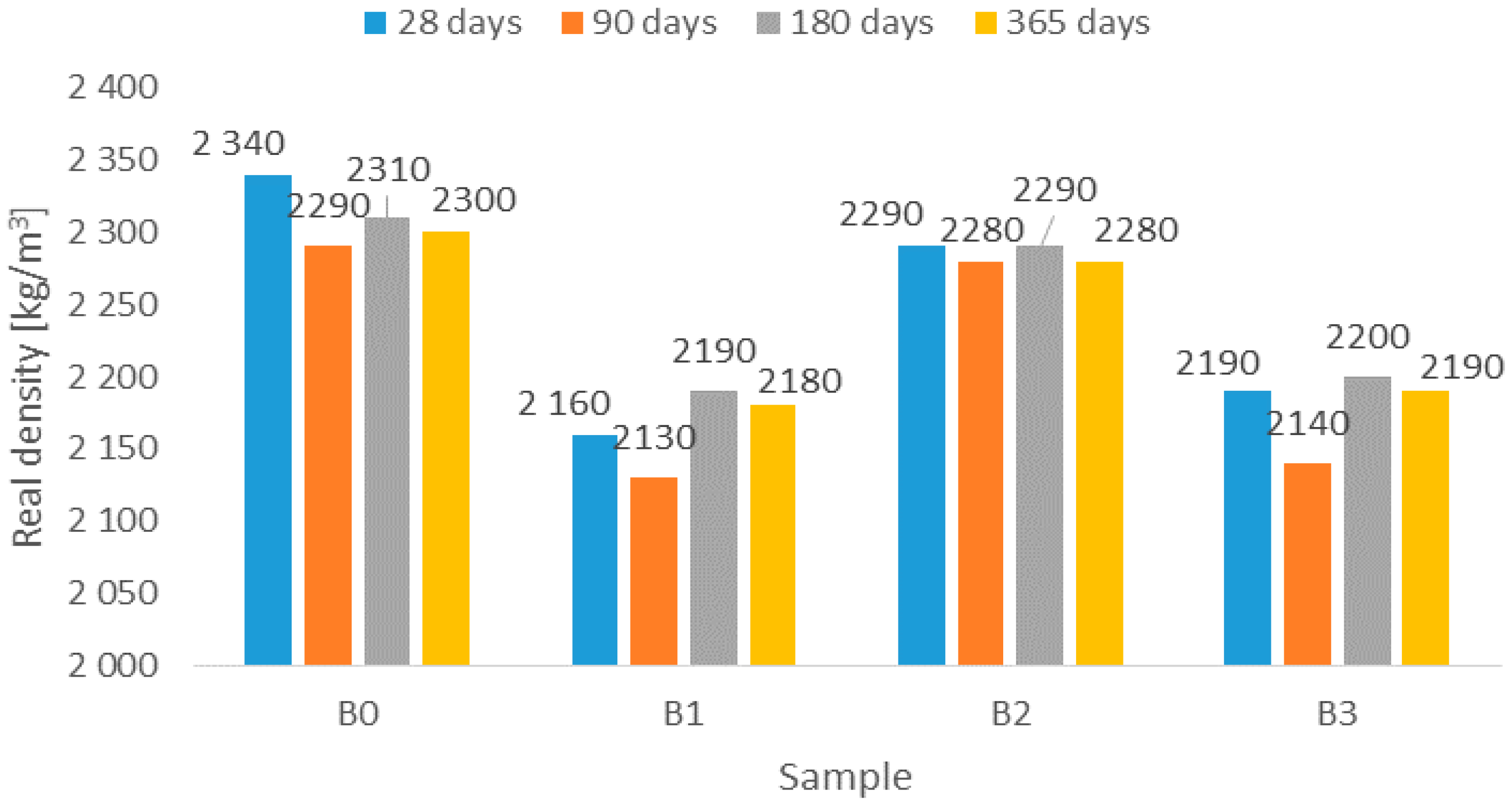
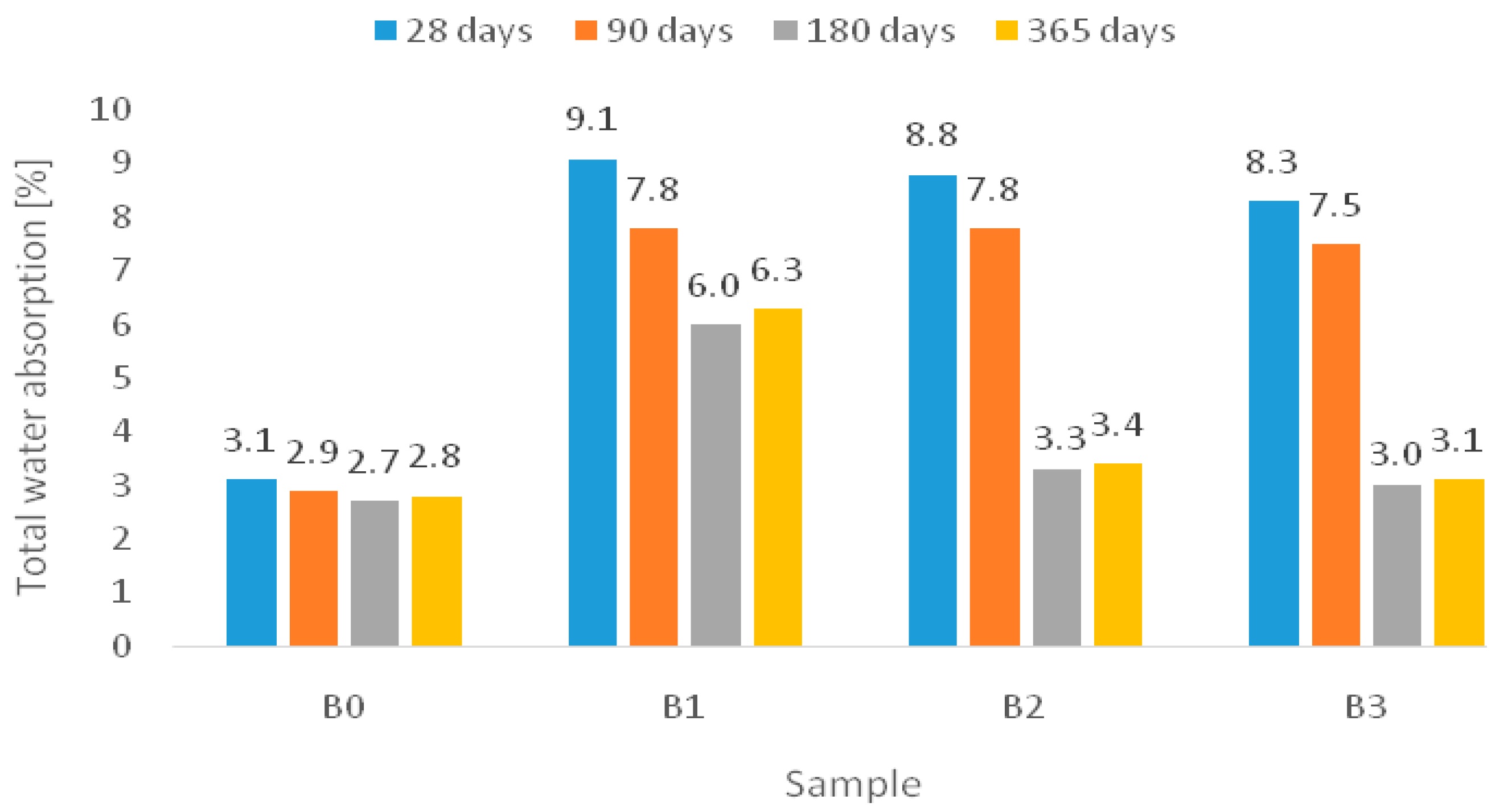
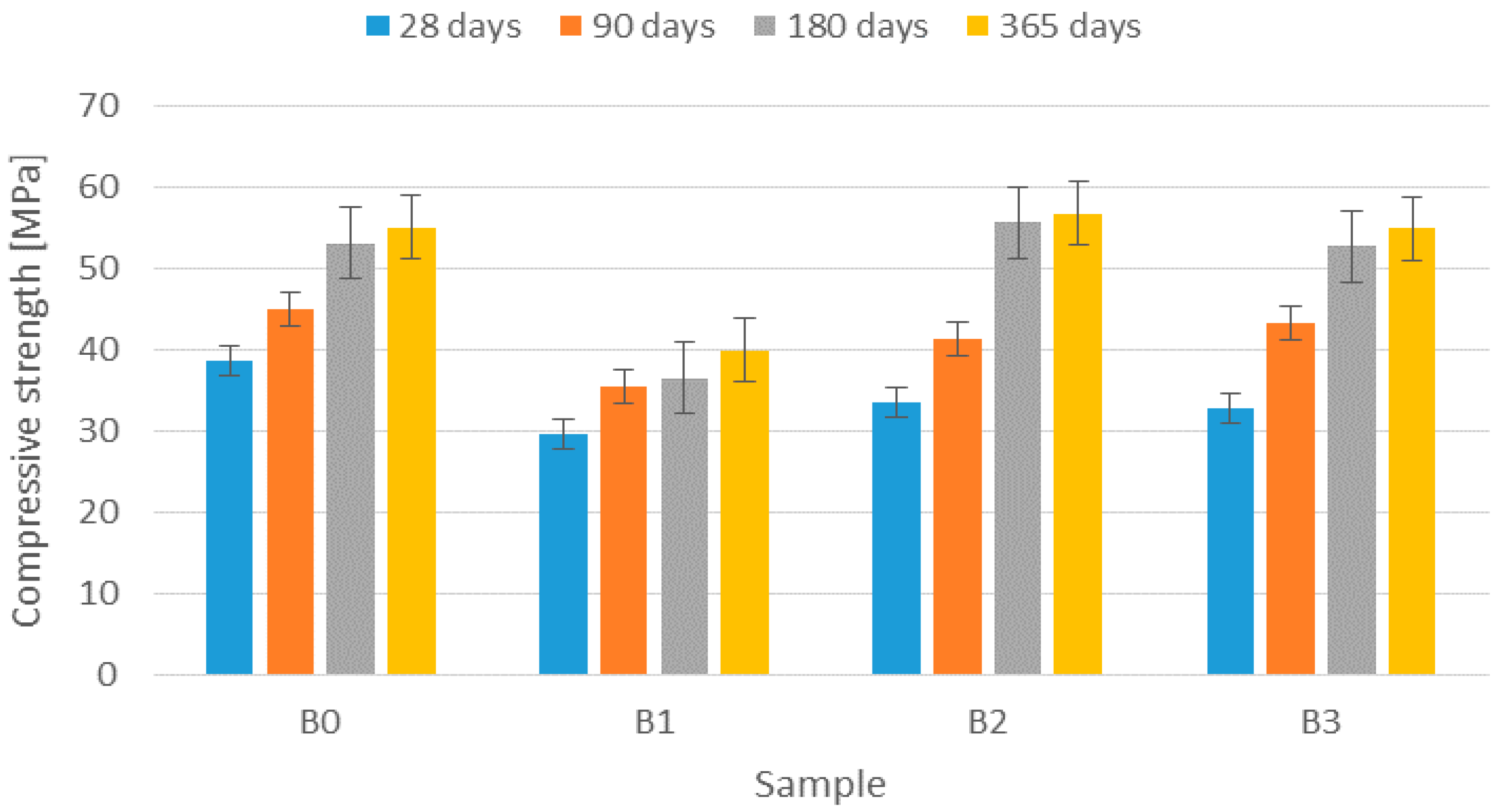
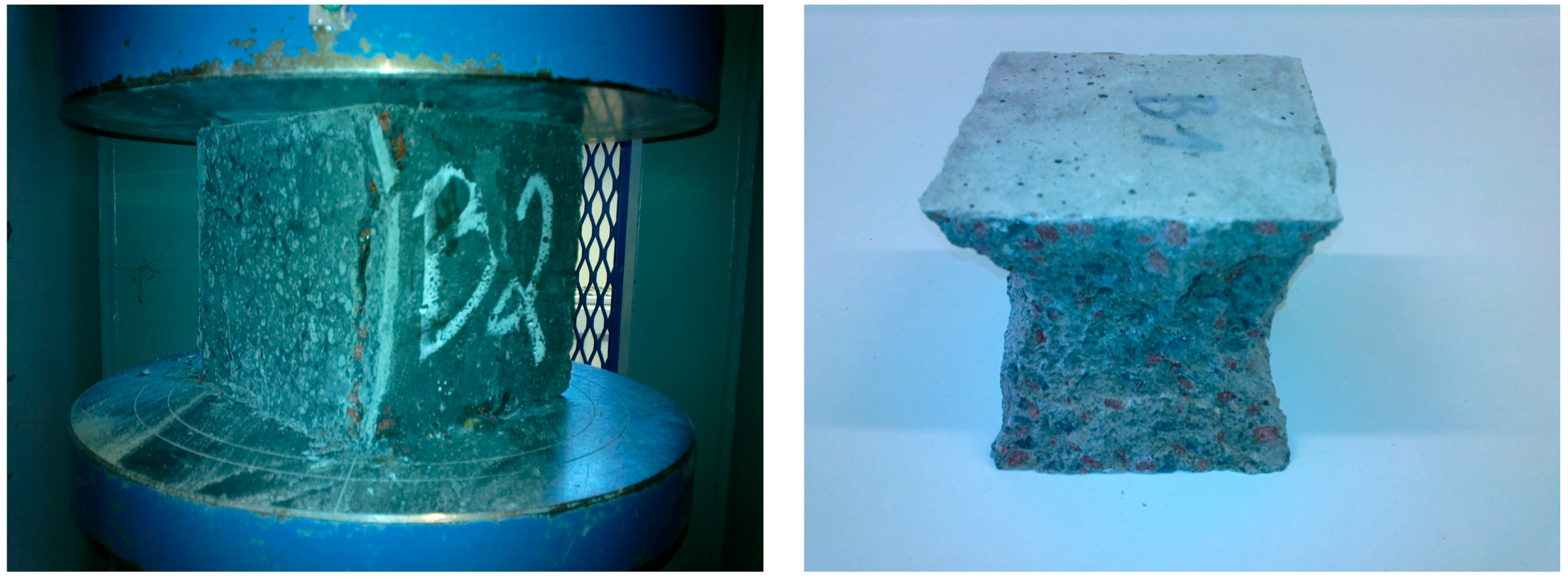
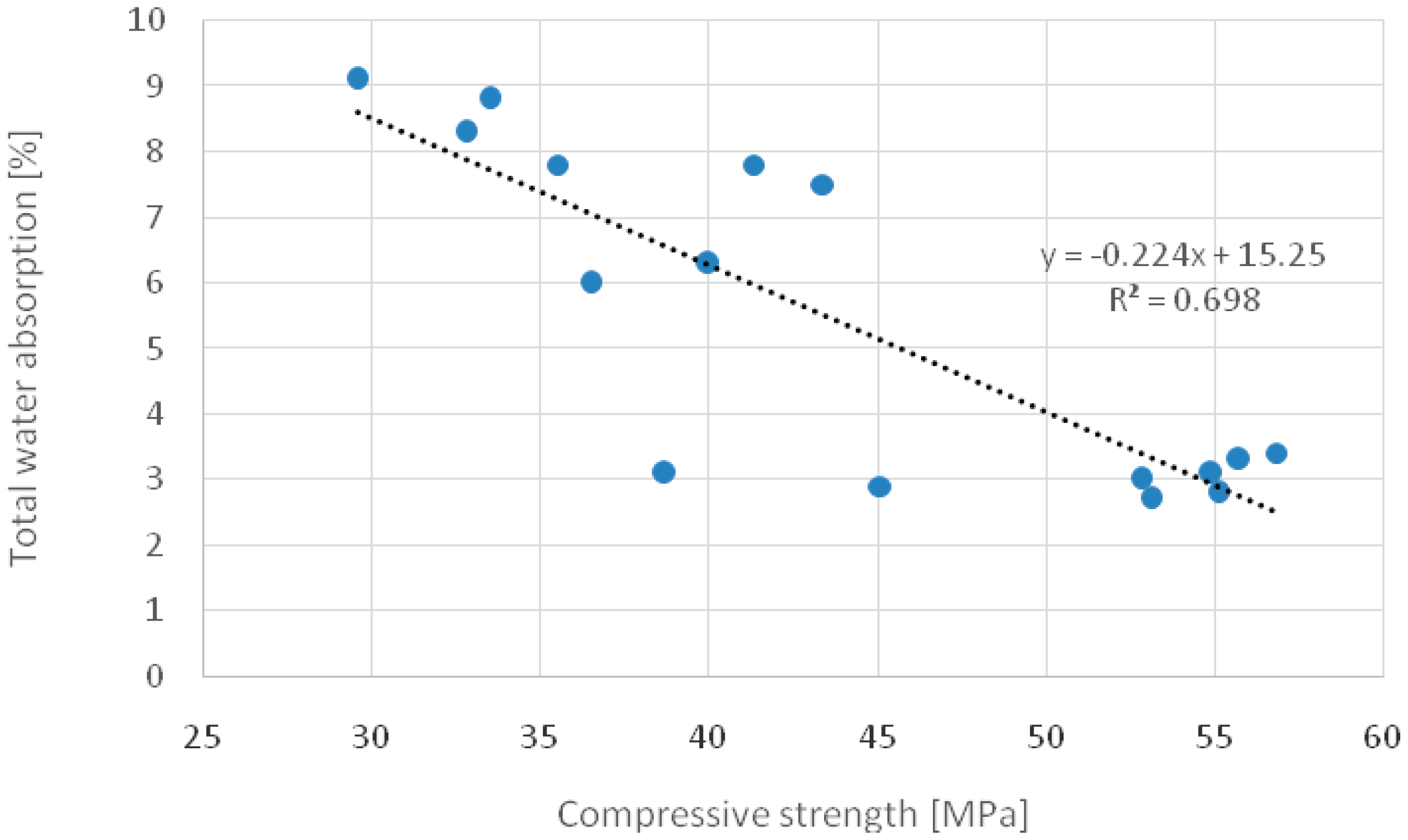
| Composition | Bulk Density (kg/m3) | Void Ratio (%) | 10 min Water Absorption Capacity (%) |
|---|---|---|---|
| RCA uncoated | 1370 | 30 | 9.9 |
| RCA coated prior mixing | 1320 | 32 | 8.2 |
| NA 0/4 | 1830 | 30 | 1.2 |
| NA 4/8 | 1580 | 39 | 1.4 |
| Sample | Agg. 0/4 | Agg. 4/8 | Mixing Details | Plasticizer (%) | Total Water (L) | ||||
|---|---|---|---|---|---|---|---|---|---|
| NA | NA | RCA | Standard Mixing | Coating RCA during Mixing | Coating RCA Prior Mixing | ||||
| B0 | ● | ● | - | ● | - | - | 0.5 | 210 | |
| B1 | ● | - | ● | ● | - | - | 0.5 | 220 | |
| B2 | ● | - | ● | - | ● | - | 0.5 | 210 | |
| B3 | ● | - | ● | - | - | ● | 1.5 | 220 | |
| Component | Composition (%) |
|---|---|
| Coal fly ash | 75 |
| Liquid glass | 9 |
| 8 M NaOH solution | 11 |
| Water | 5 |
| Sample | Decrease in Water Absorption (%) | Increase in Compressive Strength (%) |
|---|---|---|
| B0 | 10 | 42 |
| B1 | 7 | 35 |
| B2 | 61 | 69 |
| B3 | 63 | 67 |
© 2017 by the authors. Licensee MDPI, Basel, Switzerland. This article is an open access article distributed under the terms and conditions of the Creative Commons Attribution (CC BY) license (http://creativecommons.org/licenses/by/4.0/).
Share and Cite
Junak, J.; Sicakova, A. Effect of Surface Modifications of Recycled Concrete Aggregate on Concrete Properties. Buildings 2018, 8, 2. https://doi.org/10.3390/buildings8010002
Junak J, Sicakova A. Effect of Surface Modifications of Recycled Concrete Aggregate on Concrete Properties. Buildings. 2018; 8(1):2. https://doi.org/10.3390/buildings8010002
Chicago/Turabian StyleJunak, Jozef, and Alena Sicakova. 2018. "Effect of Surface Modifications of Recycled Concrete Aggregate on Concrete Properties" Buildings 8, no. 1: 2. https://doi.org/10.3390/buildings8010002
APA StyleJunak, J., & Sicakova, A. (2018). Effect of Surface Modifications of Recycled Concrete Aggregate on Concrete Properties. Buildings, 8(1), 2. https://doi.org/10.3390/buildings8010002





